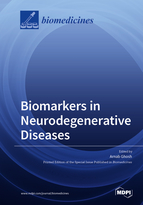Biomarkers in Neurodegenerative Diseases
A special issue of Biomedicines (ISSN 2227-9059). This special issue belongs to the section "Neurobiology and Clinical Neuroscience".
Deadline for manuscript submissions: closed (28 February 2021) | Viewed by 41285
Special Issue Editor
Interests: post-transcriptional regulation of gene expression; RNA and protein biochemistry; neurodegenerative and cardiovascular disease mechanisms
Special Issues, Collections and Topics in MDPI journals
Special Issue Information
Dear colleagues,
Millions of people suffer from various neurodegenerative disorders worldwide, with a substantial rise in the number of new cases each year. Early diagnosis, accurate prognosis, and effective treatment management are needed to increase the quality of life for these patients. Recent technological advancements in proteomics, next-generation sequencing, immunological techniques, mass spectrometry, etc. have yielded significant mechanistic insights into these ailments. This Special Issue will focus on the current advancements of basic and clinical research that would lead to the identification, development, and application of new and improved biological markers for specific neurodegenerative diseases in the future. Both original research and comprehensive review are welcome.
Dr. Arnab Ghosh
Guest Editor
Manuscript Submission Information
Manuscripts should be submitted online at www.mdpi.com by registering and logging in to this website. Once you are registered, click here to go to the submission form. Manuscripts can be submitted until the deadline. All submissions that pass pre-check are peer-reviewed. Accepted papers will be published continuously in the journal (as soon as accepted) and will be listed together on the special issue website. Research articles, review articles as well as short communications are invited. For planned papers, a title and short abstract (about 100 words) can be sent to the Editorial Office for announcement on this website.
Submitted manuscripts should not have been published previously, nor be under consideration for publication elsewhere (except conference proceedings papers). All manuscripts are thoroughly refereed through a single-blind peer-review process. A guide for authors and other relevant information for submission of manuscripts is available on the Instructions for Authors page. Biomedicines is an international peer-reviewed open access monthly journal published by MDPI.
Please visit the Instructions for Authors page before submitting a manuscript. The Article Processing Charge (APC) for publication in this open access journal is 2600 CHF (Swiss Francs). Submitted papers should be well formatted and use good English. Authors may use MDPI's English editing service prior to publication or during author revisions.
Keywords
- neurodegenerative disease
- biomarker
- diagnosis
- prognosis
- treatment management
- proteomics
- sequencing
- immunology
- mass spectrometry
Related Special Issues
- Biomarkers in Neurodegenerative Diseases 2.0 in Biomedicines (12 articles)
- Biomarkers in Neurodegenerative Diseases 2.0 in Biomedicines (12 articles)







